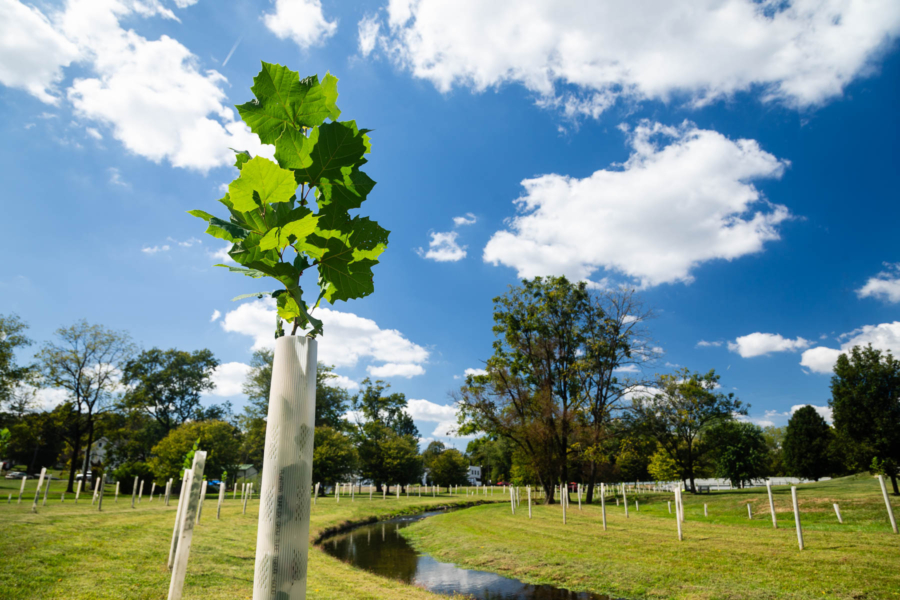Bay TMDL
The Chesapeake Bay Total Maximum Daily Load, or Bay TMDL, is a federal "pollution diet" that sets limits on the nitrogen, phosphorus and sediment entering the Bay and its tidal rivers.
The Chesapeake Bay Total Maximum Daily Load, or Bay TMDL, is a comprehensive “pollution diet” to reduce nitrogen, phosphorus and sediment loads across all seven jurisdictions in the Bay watershed: Maryland, Virginia, New York, Pennsylvania, West Virginia, Delaware and Washington, D.C. Achieving these pollution limits will help meet water quality standards for each of the Bay’s tidal segments. The Bay TMDL is the largest such cleanup plan ever developed by the U.S. Environmental Protection Agency.

Watershed Implementation Plans (WIPs)
The Bay TMDL requires jurisdictions to develop Watershed Implementation Plans (WIPs) that describe the steps they will take to meet their pollution reduction goals. Jurisdictions also submit two-year milestones to communicate their progress and ensure they are on track.
There are three phases of WIPs: Phase I and Phase II WIPs were developed and submitted to EPA in 2010 and 2012, and describe actions and controls to be implemented by 2017 and 2025. Phase III WIPs were developed based on a 2017 midpoint assessment of progress, and describe actions and controls to be implemented between 2018 and 2025. In December 2019, the U.S. EPA published its evaluation of the Phase III WIPs. To learn more, visit the U.S. EPA Chesapeake Bay TMDL website.
- Delaware: Phase I WIP | Phase II WIP | Phase III WIP
- District of Columbia: Phase I WIP | Phase II WIP | Phase III WIP
- Maryland: Phase I WIP | Phase II WIP | Phase III WIP
- New York: Phase I WIP | Phase II WIP | Phase III WIP
- Pennsylvania: Phase I WIP | Phase II WIP | Phase III WIP
- Virginia: Phase I WIP | Phase II WIP | Phase III WIP
- West Virginia: Phase I WIP | Phase II WIP | Phase III WIP
Watch: Bay 101: Restoring the Chesapeake Watershed
Guiding Documents
- Phase III WIPs Fact Sheet (PDF)
- Phase III WIPs Final Planning Targets (PDF)
- U.S. EPA Expectations for Phase III WIPs: Letter (PDF) and Fact Sheet (PDF)
- Stakeholder Assessment Identifying Lessons Learned from Phase I and II WIP Processes: Report (PDF) and Action Plan (PDF)
Setting Local Goals
As part of the Phase III WIP development process, jurisdictions documented their approaches to setting local-level goals, engaging local partners and incorporating public input.
- Delaware's Local Approach
- District of Columbia's Local Approach
- Maryland's Local Approach
- New York's Local Approach
- Pennsylvania's Local Approach
- Virginia's Local Approach
- West Virginia's Local Approach
Explaining Nutrient and Sediment Loads
- A History of Nutrient and Sediment Inputs to Chesapeake Bay, 1985-2016
- Nutrient Loads and Trends in Chesapeake Bay Nontidal Network Streams
- Dissecting Drivers of Nutrient Trends in Chesapeake Bay Streams
- Chesapeake Sediment Synthesis: Sediment sources, transport, delivery and impacts in the Chesapeake Bay watershed
- Presentation: Understanding the Influence of the Conowingo Reservoir Infill on Expectations for States’ Nutrient and Sediment Pollutant Load Reductions
- Webinar: Understanding the Influence of the Conowingo Reservoir Infill on Expectations for States’ Nutrient and Sediment Pollutant Load Reductions
Understanding and Evaluating BMPs
- The Chesapeake Assessment and Scenario Tool (CAST) is designed for environmental planners. It allows users to develop more cost-effective strategies for implementing best management practices, reducing pollution loads, and meeting Chesapeake Bay TMDL allocations.
- The Quick Reference Guide for Best Management Practices (PDF) provides a profile for each of the BMPs available for nitrogen, phosphorus and/or sediment reduction credit in the Watershed Model. Each profile includes information about the BMP, how it functions within the model, what’s needed for it to be reported for annual progress submissions and links to additional information.
- The BMP Co-benefit Presentation explains the co-benefits associated with certain BMPs, or the way these BMPs can meet both water quality and other restoration goals. The Chesapeake Bay Program’s workgroups recommended 12 outcomes to consider during the Phase III WIPs planning process and developed a series of BMP Co-benefit Fact Sheets to demonstrate why these outcomes are beneficial and how they can benefit community needs.
BMP Co-benefit Fact Sheets
- Brook Trout
- Climate Resiliency
- Fish Habitat
- Forest Buffers
- Healthy Watersheds
- Protected Lands
- Public Access
- Submerged Aquatic Vegetation (Underwater Grasses)
- Stream Health
- Toxic Contaminants
- Tree Canopy
- Wetlands
WIP Contacts
To get involved in the planning and implementation process, or to find answers to state-specific questions, please visit your jurisdiction’s website or contact your local lead.
- Delaware: Steve Williams, DNREC (302-729-9921)
- District of Columbia: Steve Saari, DOEE (202-997-9607)
- Maryland: Gregorio Sandi, MDE - (410-537-3742)
- New York: Cassandra Davis, DEC - (518-402-8152)
- Pennsylvania: Jill Whitcomb, DEP - (717-783-5205)
- Virginia: Megan Sommers-Bascone, DEQ - (804-659-1381)
- West Virginia: Samuel Canfield - (681-319-6306)
